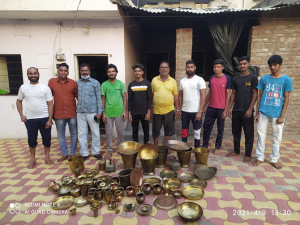THE one and a half year old ‘Bhim Rudan’ campaign by Navsarjan Trust, a prominent Gujarat-based organization working on the eradication of untouchability and all forms of caste discrimination, will be culminating with the presentation of a brass coin weighing about 2,000 kg, one of the largest brass coins in the world, to the Parliament on India’s Independence Day this year. Additionally, over 11 lakh one rupee coins will also be presented to the Parliament.
The campaign, joined by organizations such as the Dalit Foundation and the Dalit Shakti Kendra, is meant to bring attention of both the State and civil society to the removal of the practice of untouchability, with the social evil yet to be fully eradicated in spite of being barred by Article 17 of the Indian Constitution.
With the Indian government commemorating this year’s Independence Day as ‘Azadi Ka Amrit Mahotsav’ to celebrate 75 years of India’s independence, the campaign seeks to raise the question: Will the dream of 1947 of an untouchability-free India be a reality in 2047? It is a distressed reminder of Dr B.R. Ambedkar’s call for the annihilation of caste, and is meant to preserve the Constitution, as well as remind the nation to remain integrated and united, irrespective of caste differences.



The coin has been made from brass utensils donated by people from across the country. A total of 2,445 kg of brass has been donated till now, and the campaign has actually issued a request to people not to donate any more brass, as a sufficient amount had been received for the coin.
An image of Dr. Ambedkar, the chief architect of Indian Constitution, is on one side of the coin, along with the question: ‘Will the dream of 1947 of an untouchability-free India be a reality in 2047?’ On the other side, there is an image of Lord Buddha in the bhumi-sparsh mudra, along with the word ‘untouchability’ imprinted in several Indian official languages.
Each person who believes that India should be a nation free of untouchability was asked by the campaign to donate a one rupee coin. The over eleven lakh coins thus collected will also be donated to Indian Parliament, to denote that in a democracy, the Parliament belongs to all its citizens and people must own it.
The campaign is rooted in the cultural tradition of Gujarat to lay a coin in the foundation of a new house. It is inspired by the mythical sacrifice of his life for the Dalit community by the Dalit icon Megh Mahya.
The site where he is said to have laid his life is protected by the Archeological Survey of India. Since then, Dalits as well as other poor and backward communities have paid their respect to him by laying a coin in the foundation of their new house.
Since the Parliament reflects the hopes and aspirations of its citizens as it protects their rights enshrined in the Constitution, the brass coin will be presented to the Parliament, as it builds and prepares to move to a new Parliament house, as a reminder to free India from the slavery of caste.
Similarly, the one rupee coin collection initiative is inspired by a popular myth relating to the construction of a Buddha statue of gold by an ancient kingdom. As the story goes, the statue could be completed with a smile on Buddha’s face, after multiple attempts, only when a copper coin donated by an old lady was also included in the gold collected and melted to make the statue.
Both the large brass coin, and the collection of one rupees coins, will be publicly displayed on April 10 at the Dalit Shakti Kendra in Ahmedabad.


